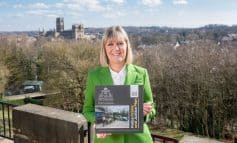A new set of ambitious climate targets are to be discussed by councillors, as Durham County Council prepares to outline its next steps to achieving net zero.
On Wednesday, June 15, Durham County Council’s cabinet will hear a final update on its first Climate Emergency Response Plan (CERP1), and details of the next steps to further cut carbon emissions.
Councillors will then be presented with a new Climate Emergency Response Plan (CERP2), outlining further climate actions to be taken from 2022 until 2024.
Within CERP2 will be the introduction of new targets, as the council sets out an improved aim to achieve net zero within its operations by 2030, and net zero by 2045 for countywide emissions.
Cllr Mark Wilkes, cabinet member for neighbourhoods and climate change, said: “Over the last year we have reviewed all our plans and are putting in place a new proactive plan to tackle climate change in County Durham.
“Our actions so far have secured significant government funding to address climate change. Additional to the environmental benefits, our climate action will help reduce council costs and protect frontline services.”
CERP 1 was adopted by the council in February 2020 and set out over 100 projects to help achieve previous targets of reducing council emissions by 80 per cent by 2030 and make County Durham carbon neutral by 2050.
Significant progress has been made on the award-winning plan through low carbon initiatives, including retrofit works at public buildings such as Abbey Leisure Centre and an £8m project to turn the council’s Morrison Busty Depot into a low carbon site, featuring a solar farm, battery storage and heat pumps.
Countywide, the council has worked with partners to plant 44,000 trees, while 16,000 hectares of blanket bog have been restored to avoid 192,000 tonnes of carbon being emitted each year.
The Scaling of On Street Charging Initiative (SOSCI) project also saw 153 electric vehicle charge points installed across the county, including rural areas.
These projects have contributed to a 58 per cent reduction in council CO2 emissions from 2008 levels and a 54 per cent reduction countywide compared with levels in 1990.
As the successor to the original plan, CERP2 has further developed both council and community-based actions with 127 schemes to meet its carbon commitments and address important issues including fuel poverty and ecology.
Projects included within CERP2 are a £5m iinvestment over two years to decarbonise heat within council buildings and a phase three development of NetPark, where designs will include no connection to the gas network and the consideration of a solar farm.
The plan will also focus on improving electric vehicle infrastructure at park and ride sites, as well as further increasing charge points countywide.
It will also explore the impact of school food waste and investigate further mine water heating projects to other suitable locations following the Seaham Garden Village scheme.
Ecologically, the plan seeks to eliminate peat-based compost through the use of recycled soil conditioner and will work to integrate the newly declared Ecological Emergency.
Cllr Wilkes added: “These are just some examples of the great work that has been, and will be, delivered in our area since the CERP1 was first established in 2020.
“Significantly reducing our carbon footprint is one of our top priorities, which is why we have set out even more ambitious goals to achieve net zero in our second climate plan.
“CERP2 reviews the progress made since 2020 and highlights current emissions against our targets.
“This plan’s emphasis is on actions that everyone as a partnership of organisations, communities, and business need to take going forward. It is time now for us to work together and take even more significant action to build on the progress that has already been made to reduce our impact on the climate.”
Cabinet will hear more details of the Climate Emergency Response plans when it meets on Wednesday, June 15, at 9.30am.








